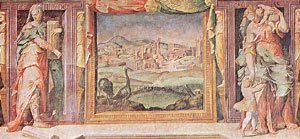![]() Fortifications
Fortifications
![]() Art in the molisian
castles
Art in the molisian
castles
Unfortunately,
due to a number of often dramatic events, the Molisian castles preserve few
traces of the often rich decorations that once ornamented the interiors. The
only building that still preserves evident signs of its ancient splendour is the
castle of Gambatesa. The entrance hall and the rooms on the first floor,
recently restored, present an exceptional cycle of frescoes depicting
mythological scenes, representations of Virtue, landscapes with animals and
trees, tondos with portraits of warriors, caryatids, torsos of archaeological
sculptures and architectural elements. The frescos, by Donato da Copertino
(1550), were commissioned by Vincenzo De Capua, Count of Termoli and Governor of
Abruzzi, of the ancient house that had obtained the vast Molisian estates once
held by the Monforte Gambatesa family.
A few traces of formerly rich interior decorations can also be seen in the
castle of Venafro. Here, in 1523, by order of Enrico Pandone, a Neapolitan
painter reproduced in certain rooms the nobleman’s favourite horses in painted
life-size high relief.
Almost exclusively
documentary, on the other hand, is the evidence of an important manufacturing
plant established at the end of the Eighteenth century in the castle of
Pescolanciano by Duke Pasquale D’Alessandro. A few rooms in the palace were
set aside to accommodate a ceramic manufactory specialised in the production of
earthenware and biscuit pottery. The latter objects in particular were very
fashionable at the time and were produced exclusively by the Reale Fabbrica
della Porcellana (Royal Porcelain Factory) of Naples. Unfortunately, the
experiment failed after a short period for a number of reasons, and few
specimens are preserved in various collections.
 |
Gambatesa |